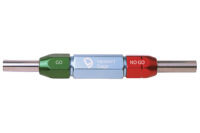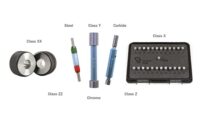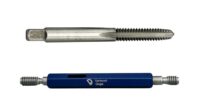Test & Inspection
AI Technical and Gage Data Searches: "Open the pod bay door, Hal."
What do Generative AI Searches have to do with inspection and gages? A great deal.

Image Source: tiero / iStock / Getty Images Plus
Information and technology are continuing to change, evolve and grow at a very rapid pace. One of these changes that has exploded recently is the use of artificial intelligence (AI). Generative AI Searches are one of the most transformative technologies of our time. The sheer volume of information that these tools analyze and responses they generate in seconds is nothing short of amazing. As with all changes, we must also accept and understand the limitations of these tools. Some users have taken the technical information supplied by Generative AI Search results and manufactured or inspected parts based on this AI generated information only to find out later that the data was incorrect. When this does happen, the results can be painful and expensive.
The source and accuracy of the information provided by these tools is one of the more critical areas of caution. AI is not evil. It is not sentient. We are not heading into a world controlled by HAL9000 from the 1968 movie and book, 2001: a Space Odyssey. However, as with all tools, we need to understand the limitations of the tool and the proper ways to use the information it generates.
So, what do Generative AI Searches have to do with inspection and gages? A great deal. Over the last three to four years there has been a significant shift in the way gage users, metrology lab techs, and customer service people get technical data and specifications to perform their respective jobs. The gage user is looking for the proper way to use the gage and understand what the gage inspects and more importantly what it does not inspect. The calibration tech is looking for the correct gage tolerances and features their customers need to accurately calibrate the gage and show the variation to the gage standards on calibration reports and certificates. The customer service representative is searching for quick correct information to advise their customers of the proper care and use of the gage. In many cases the customer service representative is also asked to supply dimensional data and tolerances.
If the information they need is not readily available, they fire up the PC or smartphone, jump on their preferred internet search engine of choice and search for data they are missing. This is when things get interesting. Three to four years ago, users would enter data into a search field and be supplied with results. The results would change dramatically depending on what was entered in the search field of the search engine. Changing the key words in the question would generate significantly different results. Generative AI has been trained to understand not just words but entire phrases and more. Even using these Large Language Models, Generative AI Search responses are not always correct.
To evaluate this, enter either of the following questions in your preferred search engine or Generative AI Search tool: “what is the max pitch diameter of a 1/4-20 UNC 2B thread?” or “What is the max pitch diameter of a 1/4-20 UNC 3B STI thread?”. As of the writing of this article, I have entered these exact questions in multiple search engines. The results are below:
Question 1:
“What is the max pitch diameter of a 1/4-20 UNC 2B thread?”
- “The maximum pitch diameter of a 1/4-20 UNC 2B thread is 0.2175 inches”.
- This is incorrect, .2175” is the Minimum pitch diameter of the ¼-20 UNC 2B Thread per ASME B1.1-2024.
- On 9/26/24 another search engine showed the pitch diameter of .2248”.
- According to ASME B1.1-2024, .2248” is the max PD for a 1B thread.
- The correct answer is .2224” per ASME B1.1-2024.
Question 2:
“What is the max pitch diameter of a 1/4-20 UNC 3B STI thread?”
- “The maximum pitch diameter of a 1/4-20 UNC 3B STI thread is typically 0.2851 inches.”
- This is correct per ASME B18.29.1-2010.
- “The maximum pitch diameter for a 1/4-20 UNC 3B STI thread is 0.2175 inches (5.525 mm)”.
- This is incorrect, .2175” is the minimum pitch diameter of a non-STI thread per ASME B1.1-2024.
It is important to note that these Generative AI tools can learn. I retested “¼-20 UNC 2B max pitch diameter” question using the selected Generative AI Search tools a few days later and received some different results. The AI search tool used in #2 and #4 above, when tested again on 10/4/24, now returns the correct PD of .2224”. Option #1 still returns the same incorrect result on 10/4/24. The correct answers were reversed when question number two was posed to the AI searches. Number 3 was correct, and number 4 was incorrect. Why does this happen?
To understand this, we need a basic understanding of what a Generative AI Search is. The current AI Searches are driven by Large Language Models (LLM). These tools are trained on vast amounts of data from the internet. Some use upwards of 175 billion parameters. So why would these AI searches come up with incorrect data? All of the available data on the internet is not correct. The AI community refer to these AI errors as the AI “hallucinating.” These hallucinations are driven by any number of possible errors in the training, insufficient data, bias in the data and other problems. In some cases, these AI hallucinations generate results that do not exist. The problem with these AI errors has less to do with the AI and more to do with us as users.
Like any computer application, the tool is only as good as the data it has access to. We as users have a responsibility to ensure the data we are supplied by these tools is correct. As with writing a college paper or trying to resolve a conflict between a vendor and customer, we must know, understand and verify the quality of the source of the data. The Generative AI Searches I tested showed the sources of the response the AI based its response upon. Unfortunately, the referenced data sources were not approved industry standards. The Generative AI searches listed articles, blogs and websites as the sited sources. (In some cases, earlier articles I had written for Quality.) Generative AI Searches do not have access to any data that is locked behind a paywall. When the AI tool searches the internet, it is only searching public information. The AI will review the data and generate a response based on what it finds as the best or most often cited data and its LLM training. (This is an extremely simplified explanation.) In the case of data used to manufacture or inspect measuring tools, most of this data is produced by non-profit organizations that bring together a group of subject matter experts to create the rules that drive the product specifications and the gages that inspect them. These groups and associations (ASME, ANSI, ISO, DIN, JIS…) peer review the data and the calculations that drive the data we use to manufacture and inspect both product and gages. All the data from these non-profit organizations is copyrighted material and stored behind a paywall. As such, unavailable to the Generative AI Search.
Critical points:
- Be sure that the data we get from the Generative AI Searches is correct and has the qualified sources to accurately generate the response.
- Use resources that refer to the specific data and calculations based on specific industry standards (ASME, ANSI, ISO, DIN, JIS…).
- Doing so will ensure that vendors and customers all refer to the same source for their data.
- When problems occur, you will have traceable peer reviewed resources to use. These traceable resources may then be used to prevent mistakes and resolve differences.
- When we are dealing with critical data that will affect how a part functions, is inspected or manufactured, it is the user’s responsibility to determine the accuracy of the data supplied and weigh the impact of its use on the parts we are making or inspecting.
AI is not evil nor is it perfect. While it is a large part of the subject matter of science fiction and pop culture, AI is not HAL or Skynet. It is a tool that will continue to evolve, grow, and improve. It is a powerful tool that we are only just now beginning to understand. The current struggle with AI is how to build in guard rails where needed. Many colleges, governments and businesses have created guides to help staff and students understand the dangers, strength and weaknesses of Generative AI. I found the following link to the University of Michigan and their guide to using AI Search Tools helpful, University of Michigan / Library / Research Guides / Health Services and Policy Research / Searching with Artificial Intelligence Tools.
The bottom line is bad data leads to bad decisions. Use only qualified sources for critical decisions. If you want a summary of an opinion, a review or public information, Generative AI is great. If you need industry specific dimensions, tolerances or specifications, use it cautiously and check your result sources for references to qualified sources. A $100 industry standard is a lot less expensive than 100,000 parts with incorrect dimensions and an angry customer.
Looking for a reprint of this article?
From high-res PDFs to custom plaques, order your copy today!





